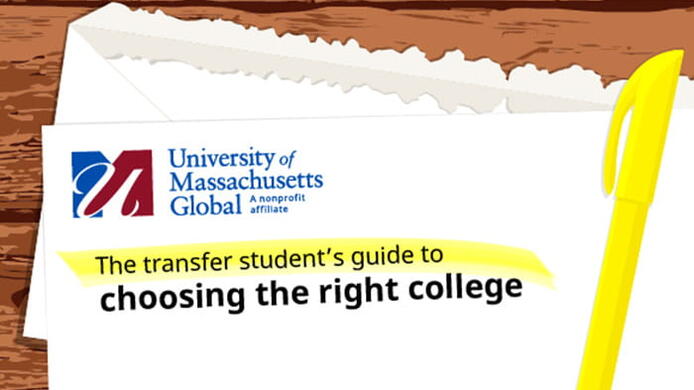UMass Global offers a wide variety of degree programs. Explore your transfer options and find a degree that fits you.

Very few students start college for the first time expecting to transfer to a different institution before they reach graduation. And yet, the most recent report from the National Student Clearinghouse Research Center reveals that approximately 38 percent of students change schools at some point during their education – and half of that group transfer more than once.
Though it’s common, transferring from one college to another can also be challenging. But it doesn’t have to be. The trick is finding the institution that can actually set you up for success. After all, not all schools are equipped to support this subgroup adequately. Amy Romm Lockard, college admissions consultant and founder of Dovetail College consulting, says transfer students tend to be underserved.
“These students are brave and self-aware enough to consider what their best fit in college is – and to actively pursue it, versus trying to force a round peg into a square hole,” she explains.
You may be looking to put your community college credits toward completing a degree program that will drive your career forward. Or maybe the school you started at doesn’t have the program you want, is no longer an affordable option for you or has simply turned out to be a poor fit. No matter what your situation is, you’re not out of luck as a potential transfer student. You just need to know what to look for in your next institution. Consider the following four elements as you begin your search.
4 Factors to Consider When Transferring Colleges
Switching schools is a bit different than starting from scratch. As a transfer student, you’ll want to keep these criteria in mind.
1. Look Into Transfer Credit Policies
The U.S Government Accountability Office estimates that transfer students lose, on average, 43 percent of their credits when transferring from one college to another. If you’ve spent time pouring yourself into your college courses thus far, the last thing you want to do is forfeit those hard-earned credits. You have to do your research.
“Do not assume just because you took a college-level course that those credits will automatically transfer to a different college,” Romm Lockard warns. She urges prospective transfer students to connect with a representative in the transfer department of the school(s) they’re interested in attending. “Learn which credits you’ve completed will transfer over,” she says. “I suggest getting this information in writing – whether by email or letter – from the individual in charge of approving your credits for transfer,” she suggests.
Transferring is more complex than you might imagine. Dr. Donald B. Scott, director of advising and retention services at University of Massachusetts Global, cautions that every institution sets parameters around the maximum number of transfer credits each student can bring with them.
“This is because every school has a residency requirement for its degrees,” he says. “For example, students need to have a minimum of 30 UMass Global credits in order to be granted a UMass Global degree.”
Amidst the complex processes in place for students hoping to transition to a new school, some states have taken measures to standardize credits that are eligible for transfer. California, for example, has implemented a transfer pathway for students graduating from in-state community colleges with an Associate Degree for Transfer (ADT) and then wishing to transfer to a four-year, independent, nonprofit institution like UMass Global.
The University is one of just two participating Association of Independent California Colleges and Universities (AICCU) institutions that accepts all 36 ADT majors from the 114 California community colleges. This means eligible students can utilize this ADT pathway to acquire guaranteed admission and junior standing – along with the acceptance of a minimum of 60 units transferred – at University of Massachusetts Global.
2. Learn About College Accreditation
A conversation about a school’s accreditation status should go hand-in-hand with your discussion about transferrable credits. In order for your earned credits to transfer to a new institution, you’ll need to make sure the two schools’ accreditation statuses align properly.
Accreditation is a voluntary process colleges and universities can opt to undergo. It emphasizes quality assurance and a commitment to continuous quality enhancement. When a college is accredited, it serves as a sign to students and employers that the school meets or exceeds the minimum standards for a particular program.
Employers look to accreditation to help determine the validity of a school’s programs to ensure a graduate is properly qualified. They may even require evidence that applicants have received a degree from an accredited institution or program.
“Always ask about the accreditation status of the college or university you’re planning to attend,” Dr. Scott stresses. “A lot of people confuse national and regional accreditation, believing national would be a better option. That’s not always the case.”
Generally speaking, credits from a regionally accredited institution or program are more widely accepted than those that are nationally accredited. Should students find themselves in a position in which they need to transfer schools an additional time in the future, earned credits from a regionally accredited college will be more likely to transfer to a new institution.
3. Consider the Timing
At many colleges and universities, transferring mid-semester is simply not an option. But if you’re unhappy at your current institution, waiting weeks or months to be able to transfer can feel like a lifetime. That’s why it’s important to consider your timeline when looking into transferring. Make sure that the schools you’re scoping out can accommodate it.
Some colleges will make this easier than others. At a school like University of Massachusetts Global, for example, students have a multitude of options.
“We have six academic terms, starting every eight or nine weeks,” Dr. Scott explains. This means that – unlike at schools with just two semesters per year – there isn’t one specific term that’s best for incoming transfer students to start.
At the same time, don’t forget to consider a school’s residency requirement. If you’re a semester or two away from graduating at your current institution, take into account that you’ll likely have to forfeit some of your earned credits if you do decide to transfer, extending your overall time spent earning your degree. Weighing these options may impact your decision to switch schools late in the game.
4. Ask About Transfer Student Support and Resources
The last thing you want to encounter when transferring to a new school is feeling like you’ve been left to fend for yourself after making your transition. “Ask some serious questions about the kind of support and resources a school has in place for transfer students – from the moment a student inquires, all the way to graduation,” Dr. Scott advises.
Dr. Scott references the resources in place at University of Massachusetts Global, which includes completing the admission’s process with the help of an enrollment coach. Transfer students will then meet with their assigned academic advisor to formulate a roadmap to degree completion. This holistic approach is an example of the gold standard for transfer students.
“We operate in a model where we have about 150 students assigned to each advisor – generally a lot of schools will have upwards of two or three thousand students each advisor is supposed to be advising,” Dr. Scott says.
It’s also worth looking into resources that can help you navigate financial considerations. University of Massachusetts Global, for example, has specialists available to help students put together a plan to pay for their education. They can help you with everything from tuition, fees and ordering textbooks to filling out financial aid forms and keeping you up-to-date on your financial aid status.
Are You Ready to Make the Change?
It’s clear there are a lot of moving pieces to consider before transferring colleges. But if you remember to look into transfer credit policies, learn about school accreditation, be mindful of the timing and inquire about student support resources before you make your decision, you’re much more likely to set yourself up for success in choosing the right next college.
“Every four-year school may feel the same on the surface, but they aren’t,” Dr. Scott offers. “Invest the time and energy to discover what experience you’re hoping to have. Ask the hard questions to ensure the new school will work for you and your goals.”
If you’re curious about what the support and resources might look like at a school dedicated to the success of its transfer students, head over to UMass Global’s Transfer Center.





